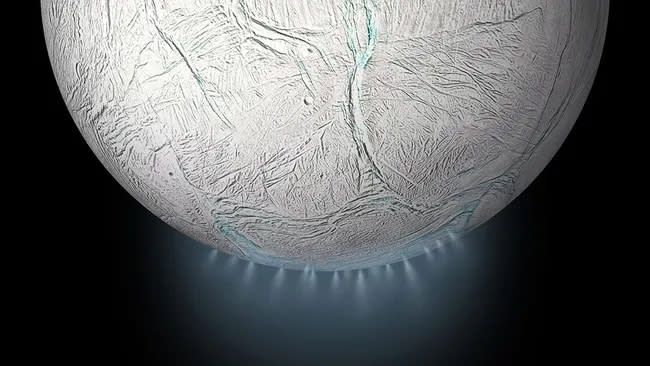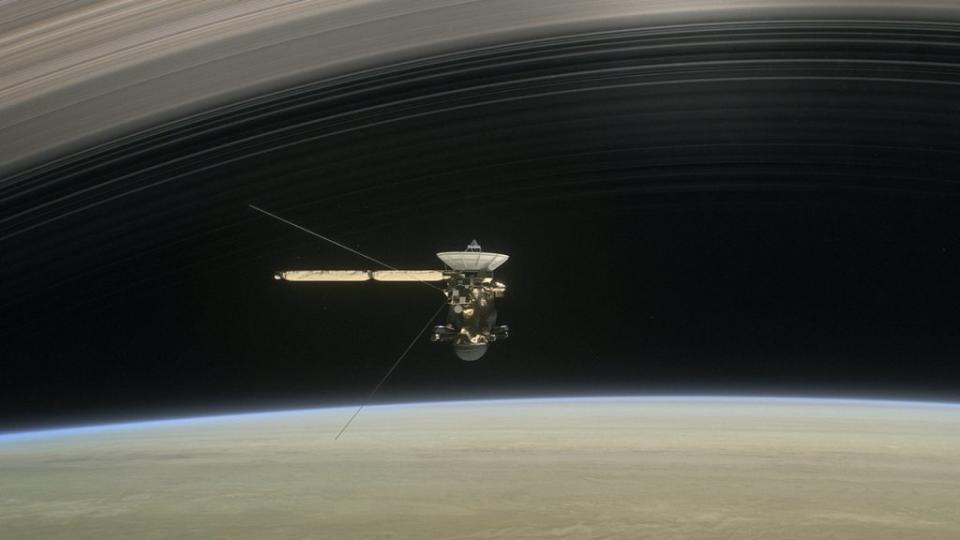Astronomers have discovered that Saturn’s small moon, named Mimas, could harbor a hidden liquid ocean under its thick icy shell and that the conditions there could be habitable.
This exciting finding dramatically changes the definition of what an ocean moon can be, and could ultimately redefine our search for alien life on moons in the solar system. That’s because, at first glance, Mimas — nicknamed the ‘Death Star’ because a large crater means it looks like the Empire’s space station in Star Wars — doesn’t look like the kind of physicists which would be expected to support the ocean. In fact, it doesn’t even seem capable of supporting such a large body of liquid at all.
The team behind the aquatic discovery estimates that the ocean lies about 12 to 18 miles (20 to 30 kilometers) below the surface of the Mimas ice crust; The researchers also believe that it is relatively young, having appeared between 2 million and 25 million years ago. But, despite remaining hidden for millions of years, the ocean appears to comprise at least half of the moon’s volume.
“The main result here is to find habitable conditions on a solar system object that we would never expect to have liquid water,” Valery Lainey, a member of the discovery team and a scientist at Observatoire de Paris, told Space.com. “It’s really astonishing.”
Related: Saturn’s moon Enceladus harbors a key ingredient for life
The discovery makes Mimas even more similar to its sister Saturnian moon, Enceladus, which scientists already knew had a subsurface ocean. The two moons are at similar distances from the gas giant planet and are similar in size, with the ice-covered Enceladus about 310 miles (500 kilometers) across and the similarly frigid Mimas sitting slightly smaller at 246 miles (396 km) across.
One key difference between the two moons is that while Enceladus’ oceans breach its surface in the form of massive jets and plumes, Mimas’ ocean has yet to crack its icy crust.
That means that while NASA’s Cassini spacecraft was able to fly through plumes of ice sprayed from Enceladus to confirm its oceans and even discover some of the complex molecules within them, the spacecraft could not to do for Mimas.
“It’s surprising that we haven’t seen anything, but the thickness of Mimas’ icy shell is enough to maintain this ocean without detecting any significant activity for millions of years,” Lainey continued. “That’s why Cassini didn’t find anything on the surface of Mimas.”
However, that doesn’t mean Cassini, which spent 13 years in the Saturn system before accidentally crashing into the gas giant in 2017, wasn’t instrumental in helping discover the Mimas ocean.

Mimas’ ‘wobble’
Lainey and colleagues found their first clues that Mimas had a buried liquid ocean when they used Cassini data to investigate a break in Saturn’s infamous rings known as the “Cassini section.”
In 2010, while trying to determine whether a change in Mimas’ orbit could be causing Cassini’s division, the team noticed a strange change in the moon’s rotation and orbit. The team determined, in 2014, that these large libraries were the result of the Saturnian moon having an imaginary solid rocky core – or, a subsurface ocean that would allow its outer shell to oscillate independently of its core.
The breakthrough came when the team finally modeled the motion of Mimas, and determined that a rocky core could only be responsible for the observations if it were elongated and flat like a pancake. Of course, this did not match what the team was seeing in real life, but in addition, the way Mimas’ orbit developed since 2014 also supported the global subsurface ocean hypothesis.
“There is no rigid interior that can be compatible with the rotation and orbital evolution of Mimas,” said Lainey. “It’s a relief that we can finally demonstrate that this is the solution.”


Moon under water
Not only were the team able to determine that the oceans have only been present for a few million years (because Mimas’ orbit is still flat, or eccentric) but the team were also able to calculate how much water there is likely to be present. in the ocean of the moon.
“At least 50% of Mimas’ volume is filled with liquid water,” Lainey said. “This is a huge amount of liquid water for the size of a satellite.”
This water seems to be grinding against the rocky core of Mimas, being heated at the same time by the friction generated by this action. This interaction also causes what Lainey describes as an “interesting chemistry” that could be developing on the Saturnian moon – right now.
Water-rock interactions are thought to have played a critical role in the origin and continued existence of life on Earth, making this chemistry on Mimas an exciting prospect for investigations of life and habitability in the solar system.
“Mimas is a small thing that looks extremely cold, with no geological activity, and you wouldn’t expect any geophysical activity inside like heating, or contact between water and silicates in its rocky core,” said Lainey. “It’s amazing to find this.”
For future investigations, Lainey said he would love to land a spacecraft on the surface of Mimas, or even Enceladus for that matter.
“I am pretty sure that any space mission to Enceladus will also visit Mimas because they are very close, and they are very similar ocean systems but at different times in their evolution,” he explained.
But with Orbilander planned by NASA to leave the Earth in 2038 and reach the second moon in 2050, such a project is still far away.
RELATED STORIES:
-Spacecraft would detect life signals shot from Saturn’s moon Enceladus, scientists say
— Methane in the dust of Saturn’s moon Enceladus could be a sign of alien life, according to a study
— Saturn: Everything you need to know about the sixth planet from the sun
Meanwhile, Lainey plans to explore Mimas from Earth to find out more about how its temperature has changed, how the presence of this ocean has affected the orbit of Saturn’s moons, and how here on the rings of Saturn and the other rings of the gas giant. moons. This could help to better calculate the age of the Mimas ocean.
“I want to emphasize that Mimas definitely does not look like the kind of thing that could be habitable,” said Lainey. “So the conclusion might be, if this object can be habitable, who knows what other kinds of objects might be habitable?”
The team’s research was published on Wednesday (February 7) in the journal Nature.